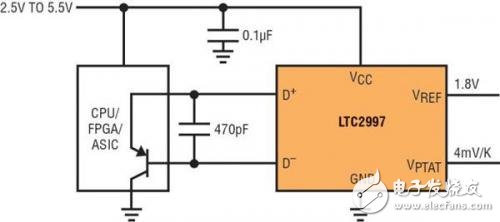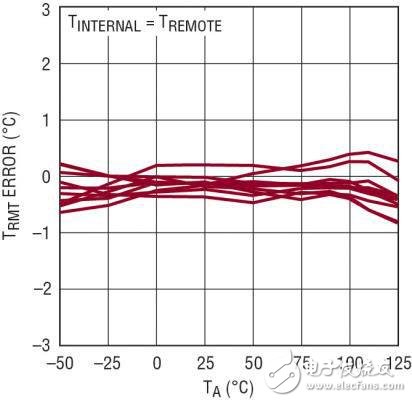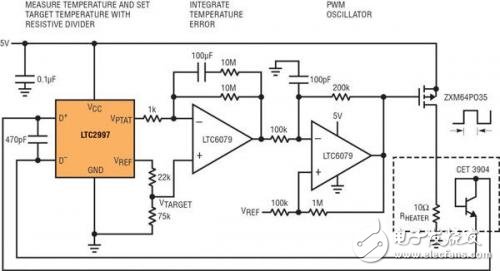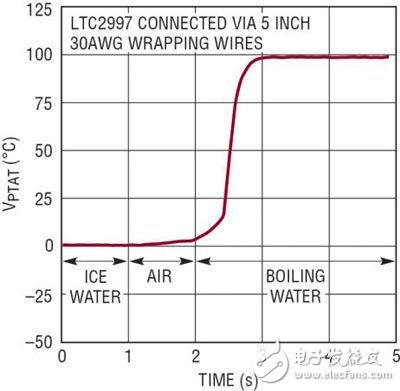Talking about the application of high accuracy temperature detector
The increasing demand for powerful computing systems has brought new challenges, particularly in managing heat. In many high-performance systems, the cooling solution often becomes a limiting factor in overall performance. Traditional cooling components—such as large heat sinks, power-hungry fans, or costly quiet fans—add physical constraints to tightly packed electronic designs. To maximize performance, reduce cooling needs, and ensure reliable operation of your electronics, it's essential to implement accurate, precise, and comprehensive temperature monitoring throughout the system.
With this in mind, Linear Technology has developed a highly accurate family of temperature monitors that can be easily integrated into various points within a system. This series includes:
- The LTC2997, which accurately measures its own temperature or that of an external diode.
- The LTC2996, which adds a threshold comparison function to detect over-temperature conditions and trigger alarms.
- The LTC2995, which integrates the LTC2996 with a dual supply voltage monitor, enabling temperature tracking and power monitoring simultaneously.
The LTC2997 is a compact, high-accuracy temperature sensor designed for applications where space is limited. It comes in a 2mm x 3mm 6-pin DFN package and is ideal for measuring temperatures in FPGAs or microprocessors, as shown in Figure 1.

Figure 1: Remote CPU Temperature Detector
The LTC2997 sends a current through the temperature-sensing diode of an FPGA or microprocessor and outputs a voltage proportional to the diode’s temperature at the VPTAT pin. It also provides a 1.8V reference voltage at the VREF pin, which can serve as a reference for the internal ADC of the processor. For configurations using an external diode, the device guarantees a measurement accuracy of ±1°C between 0°C and 100°C, and ±1.5°C between -40°C and 125°C. Typical errors are even smaller, as seen in Figure 2.

Figure 2: Temperature error as a function of temperature (LTC2997 is at the same temperature as the remote diode)
By connecting the D+ pin to VCC, the LTC2997 can use its internal temperature sensor. The VPTAT output provides a 4mV/K ramp updated every 3.5ms, ensuring fast and accurate readings.
**Working Principle**
The LTC2997 measures the voltage across a diode under multiple test currents. This technique helps eliminate process-related errors and series resistance effects, leading to high accuracy. The temperature can be calculated from the diode equation:
$$
T = \frac{q}{\eta k} \ln\left(\frac{I_2}{I_1}\right)
$$
Where:
- $ T $ is the absolute temperature (in Kelvin),
- $ I_1 $ and $ I_2 $ are two different test currents,
- $ q $ is the electron charge,
- $ k $ is Boltzmann’s constant,
- $ \eta $ is the diode ideality factor.
By measuring the same diode at two different currents, the effect of process variations (represented by $ I_S $) is canceled out, resulting in a more accurate temperature reading.
Series resistance in the wiring path increases the measured voltage at each current, introducing a positive temperature error. The LTC2997 compensates for this by subtracting a cancellation voltage, as shown in Figure 3a. An additional current (I3) is used to measure the series resistance, and once known, the cancellation voltage is set to match the error. This ensures the temperature-to-voltage conversion is accurate and immune to resistance-related errors.

Figure 3: Series resistance cancellation. (a) simplified block diagram; (b) temperature error as function of series resistance
The LTC2997 is capable of handling series resistances up to 1kΩ, with temperature errors typically below 1°C. This makes it ideal for long-distance temperature monitoring, such as when the sensor is located several meters away from the control unit. However, line capacitance becomes a concern beyond a certain distance. Capacitances above 1nF can affect the stability of the detector signal, causing additional measurement errors. For example, a 10-meter CAT6 cable has a capacitance of approximately 500pF.
Unlike many remote diode sensors, the LTC2997 features a fast update rate of 3.5ms, allowing it to accurately track rapid temperature changes. This makes it well-suited for dynamic environments where temperature fluctuations occur frequently. Figure 4 shows the thermal step response of the internal sensor when the device is moved from ice water to boiling water.

Figure 4: Thermal step response of the LTC2997 internal detector
planar magnetics transformer,planar transformer altium,flyback planar transformer,coilcraft planar transformer
IHUA INDUSTRIES CO.,LTD. , https://www.ihuagroup.com